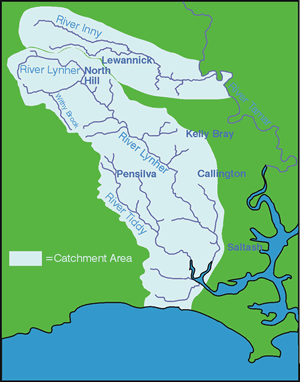lynher
and tiddy
 The
river Lynher is 34km long, rising at a height of 280m on Bodmin
Moor and flowing into the Tamar Estuary at Plymouth. It drains a
245km2 catchment and has four main tributaries, one of which - the
river Tiddy - supports a population of Atlantic salmon. There are
many smaller tributaries including Deans Brook, Withey Brook, Marke
Valley and Darleyford streams and Kelly Brook. 75% of the Lynher
catchment is populated by specialist dairy farms. In addition, there
are also a small number of beef and sheep farms and some arable
land producing potatoes and maize, both crops having a significant
water demand in the summer. The
river Lynher is 34km long, rising at a height of 280m on Bodmin
Moor and flowing into the Tamar Estuary at Plymouth. It drains a
245km2 catchment and has four main tributaries, one of which - the
river Tiddy - supports a population of Atlantic salmon. There are
many smaller tributaries including Deans Brook, Withey Brook, Marke
Valley and Darleyford streams and Kelly Brook. 75% of the Lynher
catchment is populated by specialist dairy farms. In addition, there
are also a small number of beef and sheep farms and some arable
land producing potatoes and maize, both crops having a significant
water demand in the summer. There is light silty clay loam
soil throughout much of the catchment, with an underlying geology
predominantly of slate, limestone and grit in addition to granite
on Bodmin Moor. This geology dictates low primary permeability and
porosity which , in turn, limits groundwater flow and storage. The
River Lynher is "a hard working river". Historical mining
activities (particularly in the headwaters) have led to the contamination
of watercourses to varying degrees by metalliferous compounds such
as zinc and copper. Arable farming, particularly potato and maize
cultivation, has been increasing which can result in soil erosion
leading to poor water quality and the subsequent siltation of salmonid
spawning gravels. Few fields in the catchment are truly level so
bare soil in winter is easily washed down the slopes in heavy rains.
On the light silty soils, gullies are easily formed acting as pathways
for the transfer of large quantities of soil and nutrients from
the land to adjacent water courses.
| |
| River
Lynher at Clapper Bridge |
The River Lynher is an EU designated
salmonid fishery throughout much of the catchment. It supports both
a rod and line, and commercial licensed net fishery for migratory
salmonids (Atlantic salmon and Sea trout); the river also supports
a Brown trout fishery. Stock monitoring data obtained from the Environment
Agency indicates that over the last 20 years the salmon population,
particularly the multi-sea winter stock component, has undergone
a severe decline. Further concerns have been raised with regard
to a shortfall in spawning targets and low juvenile survival from
fry to par stage (Salmon Action Plan, EA 1998).
The Lynher estuary is a designated Site of Special Scientific Interest
(SSSI) and a Special Protection Area (SPA). Many species can be
found here, including rarer species such as the kingfisher, otter,
dipper, avocet, black tailed godwit and the triangular club-rush.
|

